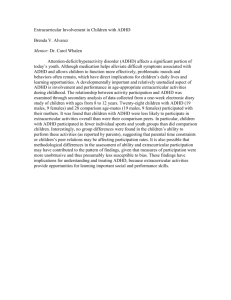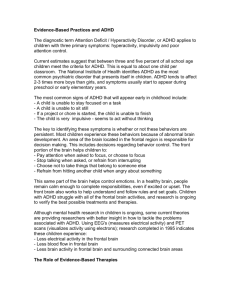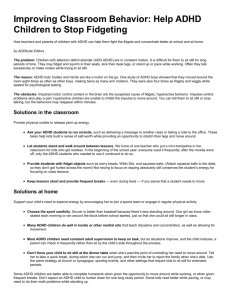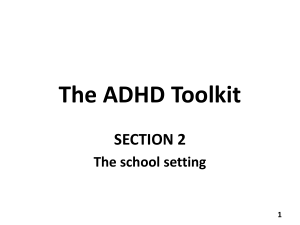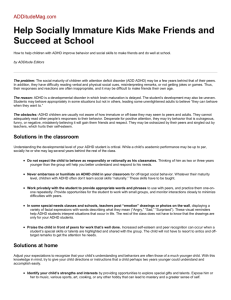ADD ADHD PP
advertisement
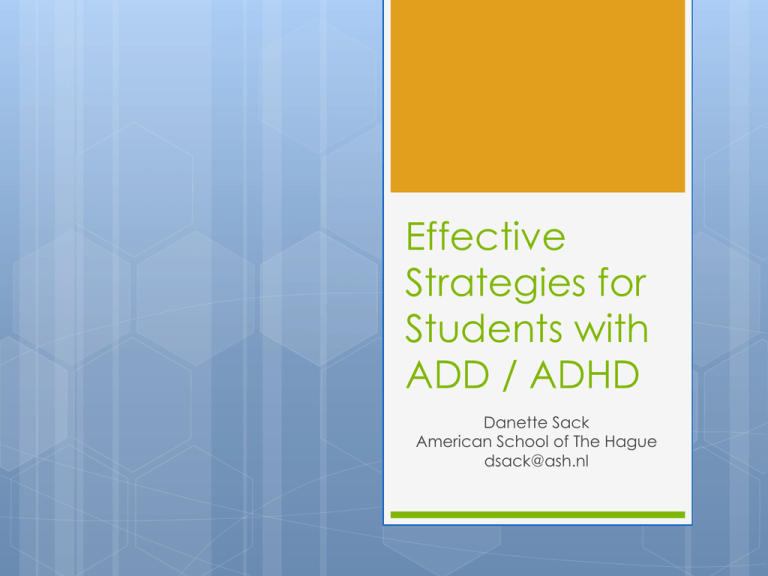
Effective Strategies for Students with ADD / ADHD Danette Sack American School of The Hague dsack@ash.nl Characteristics vary greatly ADD of students with ADD / ADHD can / ADHD is different from a learning disability – it does not effect one area, but all areas of the child’s life The variety of behaviors associated with ADD / ADHD can make it difficult to know where to start! Therefore, a systematic approach to behavioral interventions helps both the teacher and the student Effective Problem Solving Isolate Problem Behaviors Limit your problem solving to behaviors that interfere with a student’s academic achievement or disrupt the ability of others to do their work. Example: Jason calls out when the teacher is giving directions to the whole class. Analyze the Behavior Antecedent-Behavior-Consequence (ABC) Analysis When and where does the behavior take place and what typically happens as a result? Example: Antecedent: Teacher is giving directions to the class. Jason is fishing through his desk for his agenda and misses some of what the teacher says. He raises his hand, but when teacher doesn’t call on him immediately… Behavior: …he interrupts the teacher with his question. Consequence: The teacher asks him to wait until she is finished giving the directions. He persists. Teacher knows he has a hard time staying focused. Since his question is on the topic, she answers it so he’ll be up to speed with the rest of the class. Determine the Function of the Behavior Behavior that is repeated generally serves some function. It might not be socially acceptable or expedient, but it does help the student meet a perceived need. Students may have considerable insight as to why they act in certain ways. Talk to the student! Example: Jason’s questions usually come up when he misses some piece of information. The teacher spoke to him privately and asked him why he doesn’t wait until she’s finished with her instructions to ask a question like everyone else. He said it’s hard for him to focus because he’s worried about what he missed. He thinks that if he waits, he’ll forget his question. The teacher determines that when he calls out, he is alleviating his anxiety and getting the help he needs. By examining the antecedents and consequences of the behavior, a teacher may find ways to reduce the frequency of the behavior. Changes in the environment may reduce the student’s need for the behavior. Changing the response to the behavior may make it less effective in meeting the perceived need. Example: After talking to Jason, the teacher realized that she could record the steps to be done on the board as she gave instructions. This way he won’t get lost so often. When he does call out, the teacher needs to make sure that she doesn’t answer his question immediately (delay gratification). Formulate a Replacement Behavior Ideally, the replacement behavior should serve the same function as the problem behavior while allowing the student to benefit from instruction. Be positive. Spell out what the child WILL do rather than what he won’t do. Example: Jason will write down his question or a word to remind him of his question so he’ll be able to ask when the teacher finishes with the instructions. This doesn’t meet his need as quickly as before but if he knows the teacher will answer his question later, it may reduce his anxiety. Punishment, or negative reinforcement, while perhaps immediately effective, is often counterproductive in the long run. It works only to suppress problem behaviors. The net result is stifling to the student rather than empowering. Teach and Reinforce the Replacement Behavior Be explicit, concise, and consistent. It may be necessary to break the desired behavior into smaller, manageable pieces, building up to it in realistic increments. Example: When Jason enters class, the teacher reminds him to put a piece of scratch paper and a pencil on his desk. The teacher reminds him of the strategy they discussed. When he raises his hand and calls out, the teacher holds up her hand signaling him to wait, makes eye contact, and points to his paper. When she has finished with instructions, she walks by his desk to make sure he understands what he’s required to do. Before assuming attention is the problem… Both teachers referred students for “attention” problems. Peter Ben Can you identify the Antecedent – Behavior – Consequence? What is the real problem? Reflect on the Progress Exercise patience while recognizing that there is a certain degree of trial and error inherent in this process. Remember, a student cannot change his behavior until the teacher changes her behavior. COGNITIVE INTERVENTIONS Teach the student to THINK differently, in order to BEHAVE differently. These are effective and long lasting. Students may not respond immediately, so be patient! Examples: Memory strategies Self-monitoring strategies (checklists, behavior plans) Behavior contracts Mnemonics, role-playing acronyms, memory shortcuts, Cooperative learning: assign roles, provide input regarding interaction within the group Social skills training: use “teachable moments” Teach study & organizational skills Provide student insight into his learning style and teach to his strengths Teach time management strategies: use calendars, reminder techniques ENVIRONMENTAL MANAGEMENT INTERVENTIONS These manipulate the environment to promote success. They are effective and short-term. Teachers can judge the effectiveness immediately. Examples: Establish consistent routines Use special signals Use positive reinforcement Teach your rules: they are few, clear, and comprehensive; explain the rationale for your rules; make them visible in the classroom Impose rules clear consequences for not following the Employ “time outs”: these are often needed to help students regain self-control Monitor homework carefully: communicate with parents, give consistent feedback Utilize non-verbal signals agreed upon by you and the student in advance Use proximity Provide Allow different seating arrangements for appropriate movement Intervention List Think about a student you work with who has attention difficulties Can you find 2 – 3 interventions you might try with this student? Talk to your neighbor Ideal Classroom for Students with ADD / ADHD Structured routines in place Organized classroom environment Positive feedback is frequent and immediate Immediate consequences for noncompliant behavior implemented Teacher proximity is used Minor disruptions are ignored Materials are appropriately leveled Assignments Tasks are brief or chunked are mixed interest and level Multisensory teaching methods are used Transitions Problems are supervised are anticipated Communication with parents is frequent Study skills teaching is part of the daily curriculum Movement is allowed – current brain research says to add +2 minutes to a student’s age to determine amount of time before break needed ABC for Fitness Sports Galore Shooting a jump shot Batting a baseball Serving a tennis ball Skiing downhill Spiking a volleyball Swinging a golf club Throwing a football Juggling a soccer ball Shooting an arrow Swimming underwater Standing desks Exercise Balls Teacher Don’ts Don’t assume the student is “lazy”. Don’t be fooled by inconsistency. Students with ADD / ADHD can do the work one day. The next day they may not. Don’t give up on a student. These children need your persistence and belief in their ability in order to succeed. Don’t give up on behavior modification techniques. They take time! Don’t forget to talk to others. Networking with your colleagues eases your load. Don’t forget to involve parents. Be sensitive to their frustrations and fears. Don’t be afraid to adapt, provide accommodations, and alter assignments for students as needed. It is okay and fair to provide accommodations for students with special needs. Resources Included PowerPoint Effective Strategies When Teaching Students with ADD / ADHD Sample Observation Forms Peter/Ben Observation Notes ABC for Fitness Handbook

